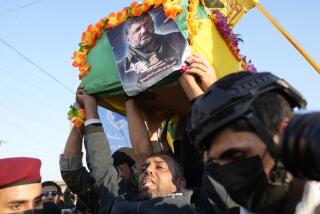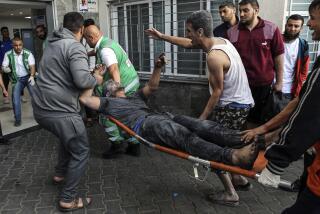Urban War, the Right Way
- Share via
Reports that Saddam Hussein is hoping to lure invading U.S. armies into protracted street battles in Baghdad have prompted visions of American soldiers caught in a nightmarish 360-degree urban battlefield--”Black Hawk Down” redux.
Given that his military is estimated to be only one-third as strong as the one routed by allied armies 11 years ago, Hussein’s best hope against an invading American force would be to exact enough casualties to wear down support for the effort in the U.S. or frighten off support for such an invasion before it began.
Toward that end, the nightmare of the 1993 battle of Mogadishu, Somalia’s capital, depicted in the book and movie “Black Hawk Down” might help convince Americans and their lawmakers that the cost of going to war against Iraq would be too high. But, in fact, the kind of urban fighting that members of Task Force Ranger faced in 1993 would little resemble such fighting in Baghdad.
The mission in Mogadishu was a limited, light-infantry assault, a lightning raid meant to capture unharmed several lieutenants of Somali warlord Mohammed Farah Aidid. The whole purpose was to get into the city and get out quickly. The mission turned into protracted street fighting only when Somalis were able to down two Black Hawk helicopters, forcing the soldiers on the ground to stay and rescue the chopper crews.
An assault on Baghdad would come with heavy force and would be designed to defeat an entrenched enemy. It would involve a large contingent of foot soldiers supported by armor and precision air support. Task Force Ranger fought without the aid of tanks or AC-130 Spectre gunships because the Clinton administration had declined to authorize these weapons. The full force of the U.S. conventional arsenal would back any move on Baghdad.
The Rangers, Delta Force, SEALs and Air Force commandos trapped in Mogadishu numbered only about 160 men. Any force employed to attack Baghdad would be many times larger and linked with ready replacements and reinforcement. The most valuable armored tool in such an assault would probably not be a tank but a bulldozer.
When the Israelis attacked Jenin earlier this year in an effort to root out Palestinian militants, their most effective weapon was a bulldozer. It proved virtually impervious to mines and booby traps and simply crushed any resistance in its path. It cleared pathways through obstacles, walls and heavily congested, hotly contested areas and knocked down structures that housed enemy combatants.
Task Force Ranger conducted its raid in Mogadishu at midafternoon because it had pinpointed its targets and had to move quickly. Any assault on Baghdad would almost certainly take place at night after severing electric lines, giving advancing American forces with their night-seeing devices a huge technological advantage.
Air support can keep enemy forces off rooftops, and sewer systems can be collapsed or flooded. Sniper suppression would involve taking and holding key observation towers and rooftops in the city and counting on the superior skills and equipment of U.S. personnel.
“The Israelis have shown that you can conduct urban assaults, moving in city streets, without taking massive casualties,” said Mac Dorsey, a retired U.S. Army colonel and former chief of staff for the Army’s Special Operations Command. “The Army and the Marines took literally thousands of towns and cities in World War II. In Vietnam, we fought urban battles very effectively, and not by walking down the street and throwing hand grenades in every window, as some later have suggested. We found the most successful tactic was simply to move down the street until we took fire, and then responding swiftly to the source of that fire. If your opponent is very determined, urban fighting becomes extremely difficult, but even then it is not impossible. In Saddam’s case, there’s a great deal of doubt about how determined such fighting would be.”
It is worth noting that even though it lost 18 men, the relatively small force of lightly armed soldiers who fought in Mogadishu, with the help of helicopters, successfully completed its mission and killed an estimated 500 to 1,000 Somalis.
An all-out urban assault would probably be much more of a mismatch. Nevertheless, fighting it out with Hussein on the streets of Baghdad would exact a terrible cost.
Rosy pre-battle scenarios rarely prove true. The Russians are estimated to have lost 200 tanks assaulting Grozny in Chechnya in 1994, a battle that left an estimated 100,000 dead. It is always possible that the Iraqi military will refuse to fight for Hussein, but this is wishful thinking. A foreign army will be invading their capital city. It is far more likely that they will fight, and tenaciously. Hussein will employ whatever weapons he can to kill the Americans, and he may find ways of killing civilians in Israel, neighboring countries and possibly in the United States.
Before going to war, a nation should always consider the worst. An all-out attack on Iraq will entail a level of risk and sacrifice that the U.S. has not assumed since Vietnam. But the question of war is not just an exercise in cost-benefit analysis. It’s about doing the right thing. It’s important to go down such a road with eyes open, firm conviction and a steady hand.
More to Read
Sign up for Essential California
The most important California stories and recommendations in your inbox every morning.
You may occasionally receive promotional content from the Los Angeles Times.










